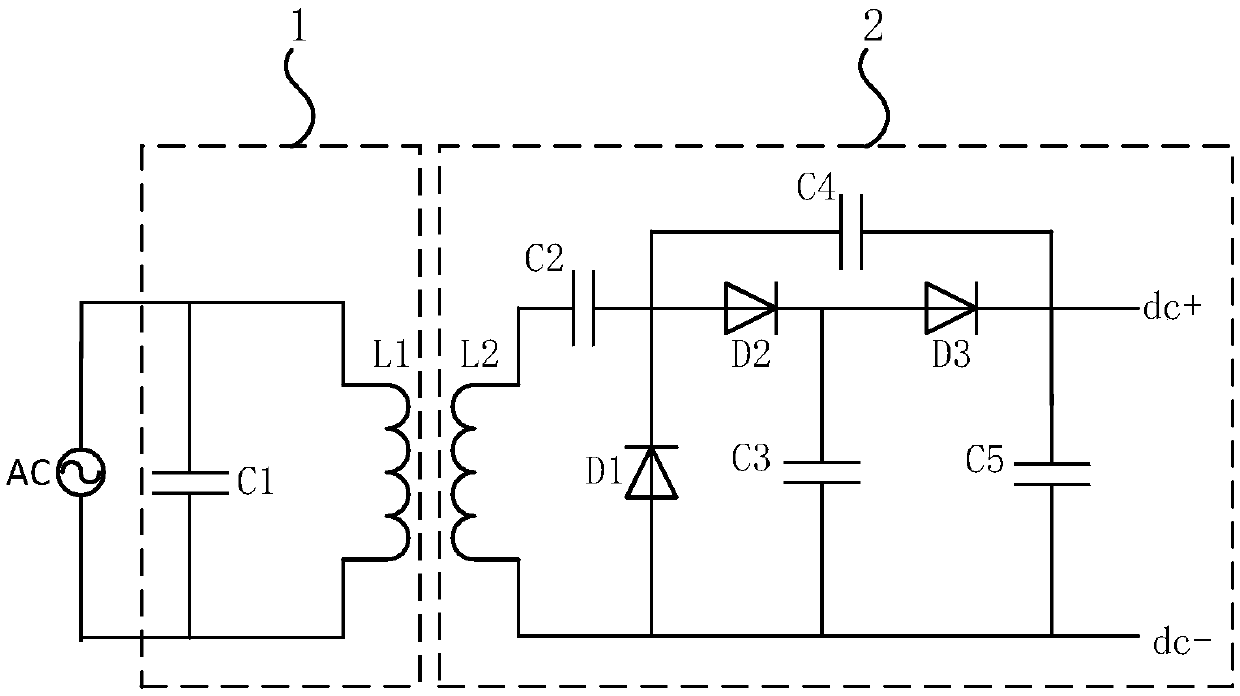Transceiver circuit for wireless charging and wireless charging system
A technology for transmitting and receiving circuits and wireless charging, which is applied in the direction of circuit devices and electrical components, can solve the problems of high energy consumption of equipment, energy conversion rate of less than 50%, energy loss, etc., and achieve the effect of improving conversion efficiency and solving low conversion efficiency
- Summary
- Abstract
- Description
- Claims
- Application Information
AI Technical Summary
Problems solved by technology
Method used
Image
Examples
Embodiment 1
[0027] See figure 1 , figure 1 It is a schematic diagram of a transceiver circuit for wireless charging provided by an embodiment of the present invention. It includes: a transmitting circuit 1 and a receiving circuit 2; wherein, the transmitting circuit 1 includes: a first capacitor C1 and a transmitting coil L1; the receiving circuit 2 includes: a receiving coil L2, a second capacitor C2, a third capacitor C3, a first Four capacitors C4, fifth capacitor C5, first diode D1, second diode D2, third diode D3;
[0028] The upper plate and the lower plate of the first capacitor C1 are respectively electrically connected to the two ends of the transmitting coil L1, and the transmitting coil L1 is electrically coupled to the receiving coil L2; the first end of the receiving coil L2 is electrically connected to The upper plate of the second capacitor C2, the second end of the receiving coil L2 are respectively electrically connected to the anode of the first diode D1, the lower pla...
Embodiment 2
[0036] On the basis of Embodiment 1, this embodiment provides a wireless charging system, please refer to figure 2 , figure 2 It is a schematic diagram of a wireless charging system provided by an embodiment of the present invention.
[0037] The wireless charging system includes: a power supply module 201, a rectification module 202, a filter module 203, a voltage conversion module 204, a power module 205, a transmitting module 206 and a receiving module 207; wherein, the power supply module 201, the rectification module 202, The filtering module 203, the voltage conversion module 204, the power module 205, and the transmitting module 206 are electrically connected in sequence, the transmitting module 206 releases electric energy in the form of electromagnetic waves in free space, and the receiving module 207 receives This electromagnetic wave is rectified into DC power for the load. Wherein, the transmitting module 206 and the receiving module 207 respectively include th...
Embodiment 3
[0041] On the basis of the above embodiments, this embodiment provides a Ge Schottky diode used in a wireless charging receiving circuit, please refer to image 3 , image 3 A schematic structural diagram of a Ge Schottky diode provided by an embodiment of the present invention.
[0042]The Ge Schottky diode provided in this embodiment includes: a semiconductor substrate 301, a Ge buffer layer 302, an epitaxial layer 303, a SiGe layer 304, and a contact electrode 305; wherein, the Ge buffer layer 302, the epitaxial layer 303, and the The SiGe layer 304 is sequentially disposed on the first surface of the semiconductor substrate 301;
[0043] The contact electrode 305 includes a first electrode of a Schottky contact and a second electrode of an ohmic contact, wherein the first electrode is disposed on the surface of the epitaxial layer 303, and the second electrode is disposed on the semiconductor substrate on the second surface of the bottom 301.
[0044] Preferably, the se...
PUM
 Login to View More
Login to View More Abstract
Description
Claims
Application Information
 Login to View More
Login to View More - R&D
- Intellectual Property
- Life Sciences
- Materials
- Tech Scout
- Unparalleled Data Quality
- Higher Quality Content
- 60% Fewer Hallucinations
Browse by: Latest US Patents, China's latest patents, Technical Efficacy Thesaurus, Application Domain, Technology Topic, Popular Technical Reports.
© 2025 PatSnap. All rights reserved.Legal|Privacy policy|Modern Slavery Act Transparency Statement|Sitemap|About US| Contact US: help@patsnap.com



